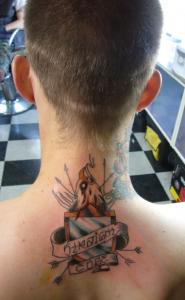Exploring the two sides of the ‘straight edge’ culture
“Straight edge” teens should be a godsend for anxious parents and vigilant police officers everywhere. Young people in the movement choose to abstain from alcohol, tobacco products, and drugs, and to resist peer pressure. But a more radical and violent side of the movement is changing the definition of what it means to be straight edge.

“Inside Straight Edge,” a powerful hourlong documentary airing tonight on the National Geographic Channel, explores the two faces of this growing youth culture: positive, tight-knit communities that try to set an example through abstinence; and more militant, fanatical groups that use their intense focus on wiping out substance abuse as justification for violence.
Sonic Youth frontman Thurston Moore narrates the documentary. His presence may help the filmmakers attract an audience interested in a youth movement that’s becoming more prevalent – and harder to define.
The term straight edge was first used in 1981 by the punk band Minor Threat. Their 45-second song “Straight Edge,” famous for the line, “I’ve got the straight edge,” unintentionally sparked the beginning of a movement focused on self-control and protest.
The images associated with straight edge are punk rockers with Mohawks, hardcore kids with tattoos covering their arms and legs, and skaters with X’s written on their hands. The message of abstinence is spread at high-energy concerts, where teens bond over their commitment and release pent-up energy and frustration from the pressures of being young.
Straight edge has grown exponentially over the past few decades and has even become something of the norm in certain towns and cities across the country. “Inside Straight Edge” looks at three cities where the movement is substantial: Boston, Salt Lake City, and Reno.
Director Shadrack Smith’s focus on these cities might seem limiting, but he includes wide-ranging interviews with teens committed to the movement for a host of different reasons, as well as police officers and parents.
Some teens, such as Pat Crane of Massachusetts and Nevada native Zeke Bilyeu, contend they are scapegoated because of violence committed by others who have very different definitions of straight edge. Bilyeu, along with members of the straight edge band Armed for Battle, take issue with a journalistic characterization of them as “white suburban terrorists.” Yet they do make clear that if antagonized, they will defend themselves and members of their community.
According to the film, law enforcement officials in Salt Lake City and Reno, where acts of straight-edge violence are common, now consider anyone affiliated with straight edge to be potentially dangerous. As a result of violence against drug dealers and users on Lansdowne Street in Boston by aggressive straight edgers and the murder of a 15-year-old in Salt Lake City, police officers in those two cities now classify the movement as a gang.
Near the end of the documentary, an eighth grader from suburban Boston stares intensely at the camera while differentiating between the positive version of the straight edge community and the violent side. Asked about his future involvement, he says, “We’re not going to go out and kill people, but I’m not going to tolerate drugs around me and the ones that I love.”
It’s an answer that ends “Inside Straight Edge” on a suitably unsettling note.
